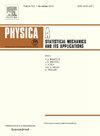Comprehensive analysis of the crypto-assets market through multivariate analysis, clustering, and wavelet decomposition
IF 2.8
3区 物理与天体物理
Q2 PHYSICS, MULTIDISCIPLINARY
Physica A: Statistical Mechanics and its Applications
Pub Date : 2025-01-18
DOI:10.1016/j.physa.2024.130330
引用次数: 0
Abstract
This research analyzes the relationship between volatility, traded volume and price in the crypto-assets market. First, the relationship between volatility and traded volume is examined, revealing a positive correlation between the two variables across a large number of crypto-assets. This indicates that increased trading volume coincides with increased volatility in crypto-assets prices, an important attribute in a highly volatile financial market. A wavelet analysis is performed in order to cluster crypto-assets according to their price and/or traded volume. It is found that the two main crypto-assets are in the same cluster when only the price variable is analyzed. However, when adding the traded volume variable to the analysis these two crypto-assets separate. This suggests that Bitcoin and Ethereum have similar behavior in price evolution but when analyzed comprehensively their behavior is heterogeneous. This analysis is carried out using a static approach and the results are contrasted using a dynamic approach by studying the evolution of the clusters over time. The results are important for investors seeking to diversify their trading portfolios with the instantaneous information provided by the market (price and volume). Through understanding the relationship between volatility, traded volume and price, investors can make more informed decisions about where to allocate their capital.
求助全文
约1分钟内获得全文
求助全文
来源期刊
CiteScore
7.20
自引率
9.10%
发文量
852
审稿时长
6.6 months
期刊介绍:
Physica A: Statistical Mechanics and its Applications
Recognized by the European Physical Society
Physica A publishes research in the field of statistical mechanics and its applications.
Statistical mechanics sets out to explain the behaviour of macroscopic systems by studying the statistical properties of their microscopic constituents.
Applications of the techniques of statistical mechanics are widespread, and include: applications to physical systems such as solids, liquids and gases; applications to chemical and biological systems (colloids, interfaces, complex fluids, polymers and biopolymers, cell physics); and other interdisciplinary applications to for instance biological, economical and sociological systems.

 求助内容:
求助内容: 应助结果提醒方式:
应助结果提醒方式:


